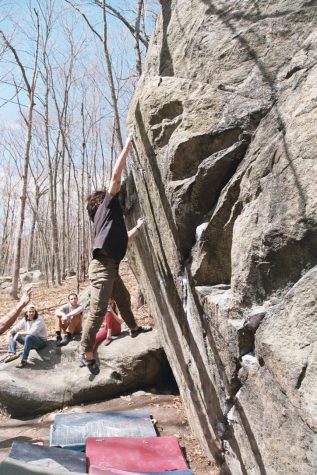Morning TV show at DHS?

Among the many ideas to change DHS for the better, is an idea to switch from announcements being made on the intercom, to the announcements being broadcasted live throughout DHS on the televisions in each classroom. While the idea has been presented in the past, the administration is pushing the idea for this school year.
Video Production Teacher Joshua Moulding said, “The idea is to use the wiring in the building to send a signal from the TV Lab to all of the rooms with TV’s.”
As of right now, the problem that the administration is trying to figure out is what to do with the classrooms with no televisions. The percentage is unknown at this time.
“We’re working out the kinks,” said Mr. Moulding. “The main issue is the fact that not all classrooms have a TV.”
Mr. Moulding said that the question is how to broadcast the announcements on the televisions with the infrastructure we have without spending money.
“If we can find a use for those TV’s besides announcements, that’d be better. It’d be a waste if the TV’s were just for announcements,” said Mr. Moulding. “The funding is an issue.”
Many schools nationwide broadcast their announcements through televisions. Draper Middle School in Albany, New York has been broadcasting their news since 2010. According to the school’s website, most days the broadcast, which can be seen on TV screens throughout the school, includes the day’s announcements and a weather forecast. Sometimes there are also special performances by students or appearances by teachers or administrators.
Senior Alison Cadieux said, “A news broadcast would be really cool. For the most part our classes have TV’s. However, some would need to be installed and most of them fixed, which could be pricey.”
What is interesting is that according to Draper Middle School’s website, rather than trying to talk over announcements that are being read over a loudspeaker, students now ask each other to be quiet so they can see the broadcast. If middle schoolers can be silent for a broadcast, high schoolers should be able to do the same.
Senior Kelly Gin said, “The news broadcasts should be like a once a week thing on a Friday or something so people look forward to it.”
Cooper City High School in Cooper City, Florida has a similar technique. According to their website, they are best known for their CTV News broadcast. New episodes air every Friday on a specific channel at 2:15 p.m., which is after school hours. The 15-minute show has not only news and sports journalism, but also sketch comedy. Other than airing to the entire school every Friday, they host many webcasts for school sporting events, including basketball and football.
Junior Jaein Jung said, “The intercom is nice, but many students can’t hear them because teachers don’t enforce silence. Even if they [the teachers] say so, it’s still rowdy in the morning, and I fear that the news will be no better.”
Jung said that the news has to be very lively and unique, like what appears to be broadcasted at Cooper City High School, in order to capture attention or else we might as well stick to the intercom.
At Mira Costa High School in Manhattan Beach, California, the “Mustang Morning News” is broadcast both on the website and in school and has been since 1999.
Senior Youssef Abi Ramia said, “I’d be down to participate in a live broadcast, but they better not censor anything.”
“I guess I’m kind of indifferent to the idea of a news broadcast, but it would be cool and worth a shot if only just to switch things up a bit,” said senior Drew McArthur.
Recently, DHS ordered a large HD TV for the cafeteria. According to Principal John Gould, the plan is to use it for the lunch show and announcements. The other four television sets will stay in the cafeteria.
Mr. Gould said, “The announcements will probably start off where the TV’s are accessible in the cafeteria. Mr. Moulding is giving me prices for a new flat screen TV in the cafeteria and students will be allowed to access that.”
An idea that has come up in regards to the broadcast, is that the live broadcast of the announcements may be made before the bell on the televisions and then on the intercom during class.
Junior Taylor Lavoie said she would rather have the announcements on the intercom. “Sometimes there are way too many at once and people zone out and get bored,” she said. Maybe with the news broadcasts, the intercom wouldn’t be as boring as people believe it to be.
“It’s just an idea,” said Mr. Moulding. “The news broadcast would be the same length that the announcements are now. Some things could be pre-produced, and then we could add in any last minute announcements.”
Another idea that has been brought up is the use of the SMART boards. “I’m working on seeing if we can stream it [the broadcast] via web,” said Mr. Moulding. “Any rooms with SMART boards or computers could stream it through the Internet.”
According to Mr. Moulding, the Internet is being upgraded as we speak. “There would be more wiring involved, but it’d ultimately be cheaper,” said Mr. Moulding.
Mr. Gould brought up the idea that if we ever did have homeroom or advisories, the broadcast would be streamed into each class through the Internet or the TV’s in there.
“For the teachers who do have TV’s, we don’t want to keep interrupting class time and stealing time from the same teachers and students,” said Mr. Gould.
As for the students who would be presenting the news, Mr. Moulding said he would propose having the broadcasts read by the Media Club in conjunction with the video production classes.
“This way, any student who’s interested can still be a part of it. They don’t have to be in the video class,” said Mr. Moulding. “They will just have to join the club. More students will be able to partake.”
Senior Macy Fernandes thought it would be a good idea to have news broadcasts. However, not all of her classes have TV’s. “I wouldn’t mind doing a live broadcast, but I don’t think I’d want a commitment,” she said.
Mr. Moulding mentioned that they could highlight the sports games and have footage for them.
“It creates a more solid community,” said Mr. Moulding. “I would like to have it if not implemented by the end of the year, then have a solid idea that starts next year.”
“It’s a great unifying tool,” said Mr. Gould.






